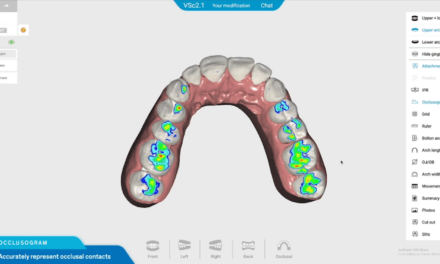Doretta Anderson is vice president of sales and marketing at IMTEC, where she has been working for the past 6 years.
OP: How do your company’s miniscrews differ from others currently on the orthodontic market?
Anderson: The ORTHO implant by IMTEC offers a simplistic approach that eliminates many of the barriers that have deterred the placement of the implant directly by orthodontists. The IMTEC ORTHO implant does not normally require an injection, flap, or even a pilot hole. A topical anesthetic is used to replace the typical local anesthetic, and the use of a small tissue punch removes the mucosa, thereby eliminating the need for an incision or flap. We have created the implant with a tapered apical that creates a self-drilling technique, engaging the bone upon the first encounter, thus replacing the need for a pilot hole. The implant’s auto-advancing thread design enables osseo-compression to occur around the screw as it is being embedded deeper into the bone. (Only in rare cases would there be a need for a pilot hole in order to begin this process.) Once in place, the ORTHO implant can be attached to by one of three ways: the neck of the implant, the .75-mm holes in the O-Ball, or the groove in the O-Cap.
OP: What products does IMTEC sell to support the use of the ORTHO miniscrews?
Anderson: Currently, we sell the O-Cap, which is a metal cap with an internal O-Ring that locks in place around the O-Ball of the ORTHO implant. The O-Cap can be used to suppress the soft tissue and prevent gingival overgrowth. There is a groove around the O-Cap that enables the clinician to directly attach ligatures, elastics, or power chains.
OP: What other IMTEC products should orthodontists be aware of?
Anderson: The MDI is a great source for the orthodontist. Although it was originally designed for the edentulous mandible, many clinicians have found it to be an invaluable adjunct when working with congenitally missing teeth. The MDI allows the patient to experience life free from the risk of losing the denture tooth while in orthodontic treatment, and free from the cumbersome flipper traditionally used in the past. And just like the ORTHO implant, the MDI is such a simple, cost-effective procedure that it no longer is cost-prohibitive to offer implants as a definitive solution for this common problem in the marketplace.
OP: What’s next at IMTEC?
Anderson: IMTEC has partnered with Hytec Inc, of Los Alamos, New Mexico, to form IMTEC Imaging LLC, which has just recently launched the latest FLASH CT technology into the dental market with the Cone Beam CT scanner, ILUMA.
The ILUMA offers the orthodontist a complete range of images for treatment planning, and also simulates final results anticipated upon completion of the orthodontic treatment.
The images give the orthodontist the technical edge to view the patient’s anatomy layer by layer from the bone to the soft tissue, displaying new angles never seen before in this field. This product should reduce the amount of time the orthodontist uses to prepare the treatment plan for each patient. Every orthodontist will be able to have access to one in his or her office due to the marketing plan presented by IMTEC Imaging. It is designed on a “pay-per-scan” basis instead of the huge capital investment that normally accompanies this type of technology.




